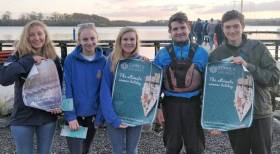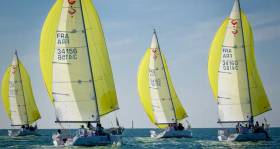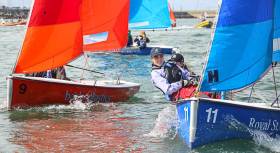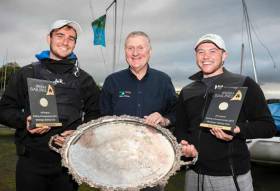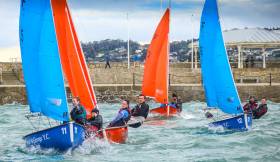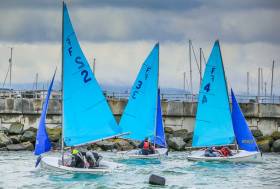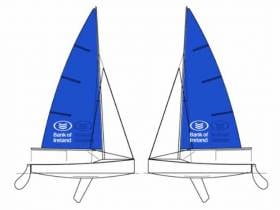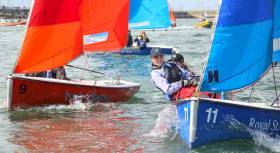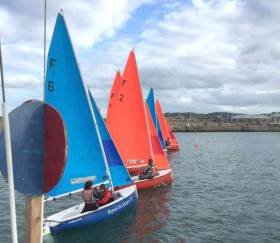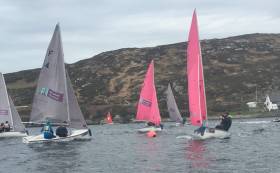Displaying items by tag: Team Racing
Trinity Win University Team Racing Battle on Lough Erne
Dublin University Sailing Club are on a winning streak with 'TCD2' winning last weekend's Irish University Sailing Association (IUSA) Northern Championships ay Enniskillen, County Fermanagh.
Hosted by QUB Sailing Club, light winds on Lough Erne provided a challenge to racing for competing teams from UCD, DIT, DCU, UCC, NUIG and QUB
Next weekend is the ITRA's at Baltimore Harbour in West Cork.
UCD Sailing Team Compete at Student Yachting World Cup
UCD Sailing Team set off yesterday to compete in the Student Yachting World Cup, held near Marseille, France. Having qualified against stiff competition at the Student Yachting Nationals in April, the team will represent Ireland in the week to come. The five day event will consist of both inshore races, coastal races and a night race, all in Grand Suprise keelboats.
Skippered by Jack Higgins, the teams consists of Patrick Cahill, Conor Foley, Nicole Hemeryck, Lucy McCutcheon, Luke Murphy and Conor Kneafsey. Following an illustrious history of SYWOC podium finishes in the last ten years, the young UCD team hopes to bring home another medal for Ireland.
It has been a busy few weeks for UCD, with the SYWOC event and the first team racing event of the season (run by UCD in Wexford) falling in the same week.
Trinity Win the Trio in Wexford
The first IUSA team racing event of the 17/18 season took place this weekend (14th - 15th of October) in Wexford. ‘Irish University Sailing Associations Easterns,’ was held in Wexford Harbour Boat and Tennis Club, and run very successfully by University College Dublin (UCD). Over 150 sailors, representing nine colleges competed this weekend. Seven teams raced in the gold fleet, ten in silver and nine in bronze. With favourable weather conditions of 12-15 knots and an ample sailing area, a total of 85 races took place on Saturday. The racing continued on to Sunday, finishing up with rounds of quarter, semi and finals. All of which, Trinity took the lead in.
Trinity remain on top as they earned the winning titles in each of the three fleets. Trinity firsts were challenged by University College Cork’s (UCC) first team in the final on Sunday. Trinity worked hard to win 3 out of the 4 races. Trinity firsts were represented by Mark Bolger, Ruairi Finnegan, Conor O’Beirne, Isabelle Deladiennee, Kate O’Reilly and Charlotte Bowen. Trinity seconds took victory in the silver fleet represented by Caitlin Waters, Sandy Aplin, Douglas Elmes, Sophie Whelton, Maeve Lavelle and Susannah Mollen. Trinity sixths earned the win in bronze fleet, represented by Aonghus Byrne, Alex Walsh, Conor Twohig, Camila Kelly, Grainne Young and Meg Tyrrell. All teams were challenged throughout the competition from stiff competition in the form of UCCs 5 teams that sailed well throughout.
Trinity’s long line of results continues having won varsities in Clifden in March of last year. Trinity lost many star sailors at the end of last year and the results from this weekend display the strength and depth that has been built up over the last couple of years. Despite the lack of fully functioning boats to train in Trinity have played the cards they have been dealt and found alternative ways to practice with events such as the Dun Laoghaire Team Racing League which was set up by Trinity at the end of September with support from the Royal St George Yacht club. Securing sponsorship for new boats, to help maintain the standard is the college teams highest priority at the moment.
The historic 70th Anniversary staging of the All Ireland Sailing Championship has seen the famous silver salver depart for a long journey to its new home in Baltimore, as the winner is Baltimore SC’s Fionn Lyden, who was crewed to the win – raced in GP 14s – by Liam Manning.
Although Lyden is currently best known as the 2017 Under 23 Bronze Medallist in the Olympic Finn, he was racing at Mullingar as the nominee of the Irish Team Racing Association, for it was through inter-University team racing that his name first registered nationally as a sailor to watch.
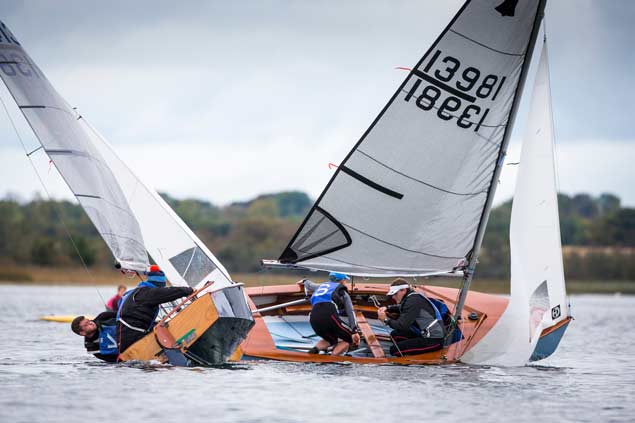 In the final race a strategic decision by Lyden resulted in a two-boat match race between him and Shane McCarthy that took place at one side of the race area
In the final race a strategic decision by Lyden resulted in a two-boat match race between him and Shane McCarthy that took place at one side of the race area
He and Liam Manning had their work cut out against a formidable field in the final, with defending champion Alex Barry of Monkstown Bay and the RS400 class, and GP14 World Champion Shane McCarthy of Greystones, both on top form.
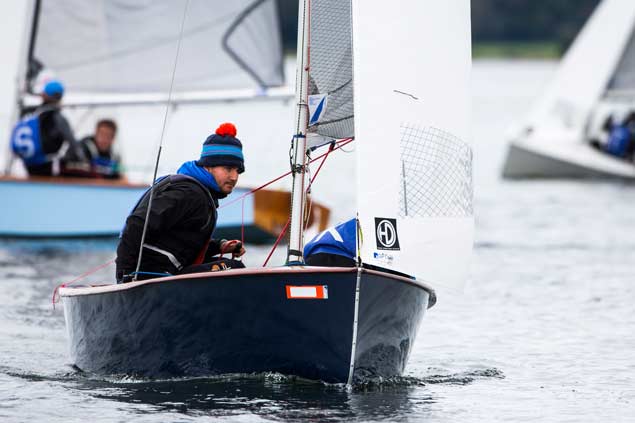 Fionn Lyden was a wild card entry on behalf of the Irish Team Racing Association
Fionn Lyden was a wild card entry on behalf of the Irish Team Racing Association
But Lyden kept his cool and finished the series with 16 points to the 18 of Alex Barry and the 19 of Shane MacCarthy, who came through to third overall in a tie-break with Laser sailor Sean Craig (Royal St George) also on 19.
Read our All Ireland preview by WM Nixon here
Irish Sailng adds (on Monday, October 9 at 1300): Fresh from winning bronze at the U23 Finn World Championships earlier this summer, Baltimore’s Fionn Lyden has won the All Ireland Sailing Championships at Mullingar Sailing Club today.
The series was decided on a knife-edge finale that saw Lyden match-race to the finishing-line with GP14 World Champion Shane McCarthy from Greystones who was denied victory by the tie-break in the series.
Lyden’s crew was fellow West Cork sailor Liam Manning from Schull and the pair represented the Irish Team Racing Association who were Wild Card entries in the championship that is celebrating 70 years.
Two very different days of racing tested the sailors: Saturday was a typical autumnal afternoon on Lough Owel – strong and quite blustery but manageable conditions apart from a few capsizes.
Sunday morning saw the repechage races to decide the last two places in the final, but then the wind dropped and the lake turned into a mirror. Patience from Jack Roy’s Race Management team was rewarded in the late afternoon when a light breeze picked up enough to allow three races in quick succession.
The going was slow, but in the final race a strategic decision by Lyden resulted in a two-boat match race between him and Shane McCarthy that took place at one side of the race area, while the rest of the fleet including last year’s winner Alex Barry battled it out for a podium place.
The final results were Fionn Lyden with crew Liam Manning of Baltimore SC; in second place were Alex Barry with crew Richard Leonard of Monkstown Bay SC , and in third was Shane McCarthy and crew Andy Davis of Greystones SC.
Blustery Start for New Dublin Team Racing League
The first round of the Dublin Team Racing League was sailed in blustery conditions yesterday in the relative shelter of Dun Laoghaire Harbour's Carlisle Pier where up to 76 short, sharp races were scheduled.
Dublin University Sailing Club hosted the first of the four League events with the goal to grow team racing in the Leinster region.
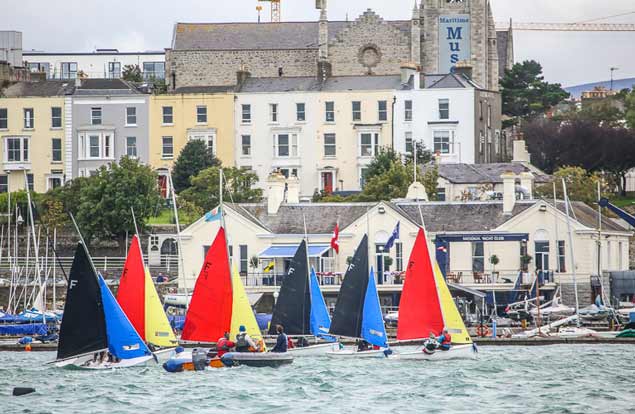 Reefed down Fireflies team racing in front of the National Yacht Club Photo: Afloat.ie
Reefed down Fireflies team racing in front of the National Yacht Club Photo: Afloat.ie
The League built on last month's Elmo Cup momentum at the Royal St. George Yacht Club and bridges the gap to college team racing with young sailors ranging from secondary school to university students participating.
Although the league will be held in Dublin, anyone from around the country is welcome to enter a team regardless of age or ability.
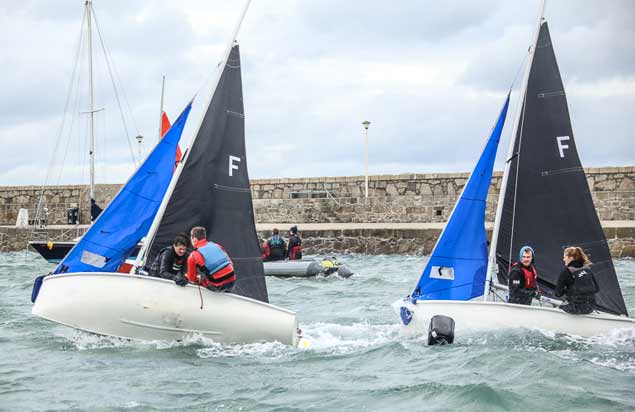 The breeze touched 20–knots for team racing in Dun Laoghaire Harbour Photo: Afloat.ie
The breeze touched 20–knots for team racing in Dun Laoghaire Harbour Photo: Afloat.ie
Dublin Team Racing League Aims to Build on Elmo Cup Momentum
The Dublin University Sailing Club is hosting the first of four Dublin Team Racing League Events in Dun Laoghaire this Saturday, 7th of October. As discussed at the ISA meeting earlier in the year, the goal of the League is to grow team racing in the Leinster region.
Although the league will be held in Dublin, anyone from around the country is welcome to enter a team regardless of age or ability. We are trying to develop sailors, jury and race organisers. These events should be seen as an opportunity for beginners and more advanced team racers to learn.
The League aims to build on last month's Elmo Cup momentum at the Royal St. George Yacht Club and bridge the gap to college team racing.
Teams will be selected to compete in the league on a first come first served basis. Teams can sign up by filling out this google form here.
The number of teams we can accommodate depends on the number of boats we can sail, so if there are fireflies available to use in your club that would benefit the league, please let us know. Any help with this league is greatly appreciated.
The League will run through the winter and should finish up around March/April. As addressed in the meeting earlier in the year, the main issue with team racing is that the majority of racing is done by college sailors who then spend the summers abroad. The idea behind this league is that once it finishes up early next year, the sailors and race organizers that have benefited from racing with us can continue to team race in a summer league. And the league can continue all year round, building year on year.
As the weekend after next is the first Event of the League, we will also be running a team racing talk next Wednesday evening in Trinity College. This talk will be free of charge and prepared and given by some of the sailors from its top team. It is an opportunity for sailors who are not heavily practiced team racers to bring their TR strategy up to speed prior to the first league event (this is also open to anyone who is interested, whether they are racing or not).
More information for the evening, event format, costs, and location will be available in the next couple of days. If you have any immediate questions about the event please contact: Jack Kennedy – [email protected] or Mark Bolger – [email protected]
UCD Sailing Club Get New Team Racing Sails
As the new year of University team racing sailing kicks off, UCD Sailing Club announces it has 'extended its partnership' with sponsors Bank of Ireland so the club sets sails with brand new North sails for its Dun Laoghaire based Firefly dinghies for the next couple of seasons.
Skiff Squad Victorious at Royal St. George's Elmo Team Racing Trophy
Royal Cork Yacht Club's Durcan brothers, Harry and Johnny, along with Atlee Kohl, James McCann and Emily Cullen and Ciara Little from the RStGYC emerged as winners of the third Elmo Team Racing Trophy youth team racing competition, sailed in the RSGYC over the weekend.
Download the overall results below as an Xcel file.
Their edge over the competition was evident, winning all 16 of their races, beating the visiting West Kirby Sailing Club team in the final on Sunday afternoon.
The RSGYC 1 team (Toby Hudson Fowler, Greg Arrowsmith and Henry Higgins) beat their clubmates RSGYC 3 (Helen O'Beirne, Niamh Henry and Morgan Lyttle) to take 3rd overall. A team comprised of Laser 4.7 sailors captained by Tom Higgins won the Silver fleet, with the National Yacht Club winning the Bronze fleet.
 Saturday saw 81 races sailed inside Dun Laoghaire Harbour. Photo: Afloat.ie
Saturday saw 81 races sailed inside Dun Laoghaire Harbour. Photo: Afloat.ie
18 teams took part in the event, with most of the top youth sailors in Ireland competing. Perfect conditions for team racing on Saturday saw 81 races sailed - a credit to the organisers of this growing event. Racing on Sunday morning had to be postponed until the wind died down a little, but race officer Ger Owens successfully managed to get over 30 races sailed in testing conditions. Given the level of interest in the event, and the high standard of racing, the future of team racing in Ireland is looking very bright!
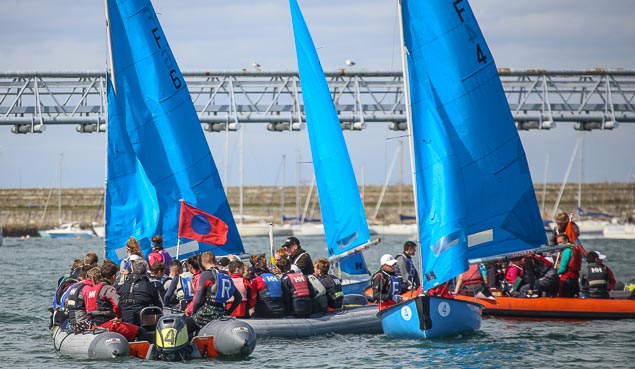 Teams afloat and ready to race in Royal St. George's Firefly fleet
Teams afloat and ready to race in Royal St. George's Firefly fleet
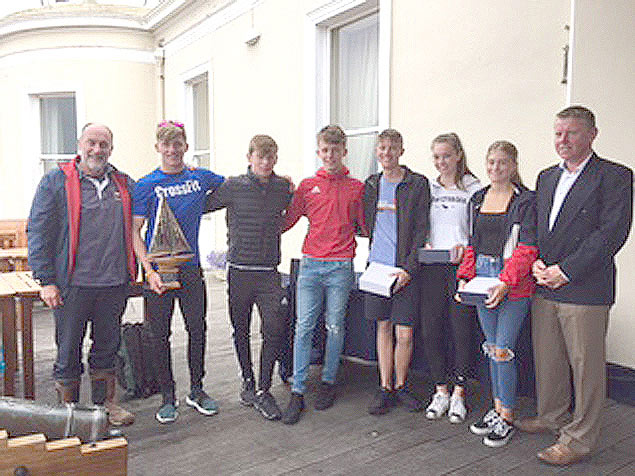 Elmo Trophy winners - 'The Skiff Squad' above, below West Kirby and bottom Team George 1
Elmo Trophy winners - 'The Skiff Squad' above, below West Kirby and bottom Team George 1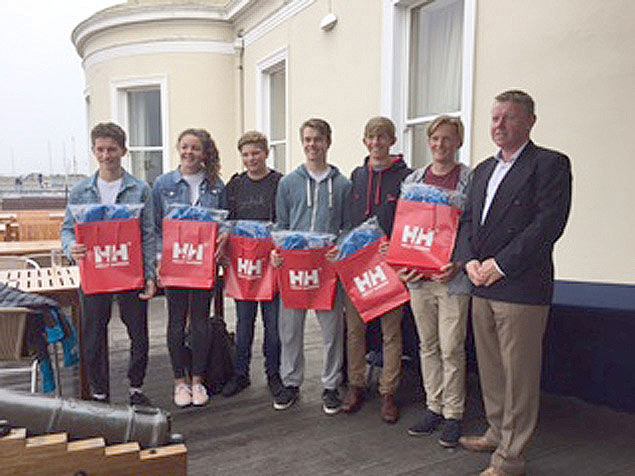
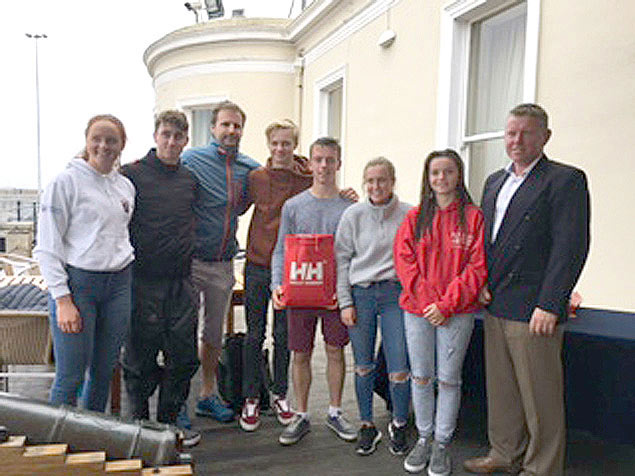
High Profile Team Racing Entries for Royal St. George's Elmo Trophy
This weekend sees a high profile list of competitors taking part in team racing's Elmo Trophy, being held in the Royal St. George Yacht Club in Dun Laoghaire. This is the third year of the junior team racing event, named after the late Graham Elmes, founder of the Irish Team Racing Association.
Reflecting the growth in team racing among our young sailors, there has been huge interest in the event this year.
18 teams from around Ireland and the UK will be competing over two days, with teams of 6 under 18–year–olds sailing in two man firefly dinghys. Indeed, five additional teams had to be turned away as demand was so great to secure places.
The line up includes Laser sailors Johnny Durcan, Ewan McMahon, Luke McGrath, Conor Quinn, Jack Fahy, Sally Bell, Tom Higgins, Henry Higgins, Claire Gorman, Michael O'Sullibhan, 420 sailors Geoff Power, Kate Lyttle and Grace O'Beirne, RS200 sailors Toby Hudson Fowler and Greg Arrowsmith, RS Feva champions Henry Start and Morgan Devine and, of course, 29er sailor Harry Durcan - to name but a few.
Team Racing Clinic At Royal St George YC Next Week
#TeamRacing - The Royal St George Yacht Club next week hosts a clinic in team racing — which is quickly gaining a reputation as Ireland’s most enjoyable and fastest growing type of sailing for teenagers.
Running from Monday 14 to Thursday 17 August, and with some of Ireland’s top youth team racers as coaches, The Royal St George says the clinic promises to be a great week.
The team racing clinic is open to sailors of all experience levels, aged between 13 to 18 years, and will be sailed in the club’s team racing Firefly dinghies.
The cost is €120 for members (€150 for non-members) which includes coaching, use of the club boats and lunch daily. Single days’ coaching is also available for €30 (€37.50 for non-members).
Places have been filling up quickly so act fast of you want to take part. Click HERE for more details.


























